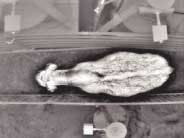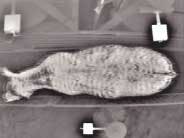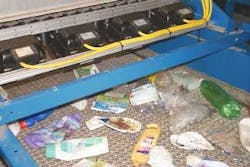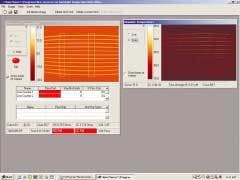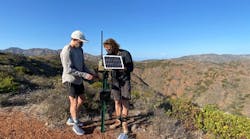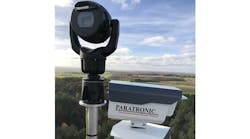Better performance, lower price, and new interfaces open process-control options.
By R. Winn Hardin,Contributing Editor
Infrared (IR) cameras, often referred to as thermal-imaging cameras, have been called "the technology of last resort" for machine-vision applications. The most often cited reason for this is the cost of IR cameras. Until the advent of uncooled IR cameras, these imagers cost $30,000 and up for a camera with a 160 × 120-pixel focal-plane-array (FPA) sensor.
Optics is also a problem because glass absorbs IR radiation, so IR camera manufacturers have had to use exotic, expensive materials, such as germanium and calcium fluoride, for optics and enclosure windows. However, recent developments in sensor technology, optics, and cabling are pushing thermal imagers into machine-vision solutions, opening up new applications that are not possible using standard visible-light CCD cameras.
"The arrival of uncooled [IR] cameras and the drop-in cost and increase in performance are driving thermal imaging to machine vision," explains Pierre Potet, president of CEDIP Infrared Systems. "But it's not just cost—it's a combination of cost and performance. Performance is usually measured in the number of pixels. In the past you had 160 × 120 pixels for the same price we have 320 × 240 pixels today, which opens a wider number of potential applications."
Increased resolution of IR cameras has allowed CEDIP to sell IR automated optical-inspection systems into electronics-manufacturing applications. "If you have better spatial resolution, you can inspect printed-circuit boards, for instance, when they come out of the [solder reflow] oven," says Potet. "More pixels mean you have better definition and can look at smaller components." Potet suggests that integrators should know how the surface finish of the part impacts an IR system, as well, since highly reflective surfaces can reflect ambient IR radiation in addition to emitting IR radiation of their own.
Despite the increase in array size, most machine-vision applications make either a qualitative or quantitative measurement based on the temperature of an object or process, rather than making a spatial measurement. "Reading fine geometries is a challenge for thermal cameras," notes Stan Kummer, public safety and industrial markets director at Raytheon Commercial Infrared. "Visible cameras and careful lighting will still be superior choices due to higher pixel counts when very fine geometries are involved" (see Vision Systems Design, December 2003, p. 35).
TEMPERATURE MEASUREMENTS
Within process monitoring, Paul Czerepuszko, OEM business development manager at FLIR Systems, breaks down the application base into nontemperature and temperature measurement. Nontemperature measurement refers to systems that use IR cameras to enable subjective decisions based on relative differences in object temperature. Temperature measurements require a radiometrically calibrated IR camera that can accurately interpret the temperature of targets and, ideally, compensate for changes in ambient temperature that can affect the camera's ability to determine an absolute temperature reading.
One illustration of a qualitative, nontemperature measurement application is livestock sorting. "One of our customers built a unique system that uses an IR camera to determine how big a cow is coming down a chute," describes Raytheon's Kummer. "If the cow is of a certain size, the system opens up one gate, and, if it isn't big enough, it opens another gate to another pen.
"The thermal alternative is interesting because in a dirty environment there isn't much visual contrast between the cow, the ground, and so forth, but in a thermal contrast you get a distinguishing outline of the cow, which you can lay against some preconceived images based on a fixed distance. You make the decision based on what percentage of the screen represents your target size, and sorting is done automatically," says Kummer. Although thermal imaging doesn't work well in a moisture-rich environment because water absorbs IR radiation, IR is far superior to visible in dust-laden or particulate environments because the wavelength is longer and penetrates the obscurants (see Fig. 1).
null
To make temperature measurements using an IR camera, the camera must compensate for ambient drift in addition to nonuniformity correction (NUC), an algorithm common to most IR cameras that compensates for different sensitivity levels among the pixels that make up the sensor. While NUC calibration is provided by the manufacturer at the factory, ambient drift compensation requires temperature sensors in the housing of the camera near the optics and sensor.
Like CCD-camera manufacturers, IR camera manufacturers specify that the camera should only be used between –10°C and 50°C when there are no special enclosures, coolers, heaters, or other environmental-control systems. Even within the preferred operational range, most IR cameras need to correct for heating/cooling of the optics and the sensor housing to make robust temperature measurements.
According to CEDIP's Potet, the luminance generated by an increase of 10°C in the camera housing can generate four times more signal than the increase of the scene temperature by 10°C, when using an ƒ/1 lens. Temperature measurements also can be impacted by IR-emitting objects, such as light bulbs, that fall within the camera's field of view. In these cases, the system integrator must use baffles, enclosures, windowing of the image, or other methods to filter out the stray IR light when making temperature measurements.
Short-wavelength-IR (SWIR) or near-IR (NIR) cameras based on indium gallium arsenide (InGaAs) are an example of one exception to the rule. Unlike microbolometers or ferroelectric long-wavelength sensors sensitive to IR radiation in the 8–12-µm range, SWIR cameras, such as those from Sensors Unlimited, are most sensitive between 0.9 and 2.5 µm. These cameras do not require compensation for changes in temperature to the optics, environment, or the housing beyond that required of visible light CCD or CMOS sensors (see "Detector options" on p. 56).
"Once something goes above 120°C, it starts to be detectable in the SWIR," explains Martin Ettenberg, director of imaging products at Sensors Unlimited. "The real advantage to NIR, however, is that you can use glass optics instead of more-expensive optics such as germanium, silicon, or sapphire. That can be very useful in a thermal process where there is spillage, such as molten material. If the material hits a germanium window, you have to throw away a $30,000 window, and that can make your machine vision very expensive." Ettenberg adds that SWIR cameras only need to be radiometrically calibrated once for each application to take into account absorption from the optics, part reflectivity or emissivity, ambient lighting, and other considerations—the majority of which do not change in an industrial automated optical inspection application.
The NIR is also a good part of the spectrum to use to make decisions based on physical properties of materials beyond shape. Recently LLA Instruments multiplexed 32 spectrometers to Sensors Unlimited NIR linear arrays to sort plastic bottles passing down a recycling line. The spectrometer filters the radiation to the NIR spectrum, then passes the resulting signal through a series of optics that spread the remaining NIR spectrum across a NIR linear array. Based on the intensity of the IR radiation on each pixel, the system automatically differentiates between many different types of plastics, such as polypropylene and polyethylchloride (see Fig 2).
"Since we're trying to discern what type of plastic we have, you need more content information, which is why our customer put a spectrograph in front of the array. If you had very different types of materials, you could use just an imaging array and bandpass filter and say this is material A so accept it and reject materials B and C," explains Sensors Unlimited application engineer Doug Malchow.
IR AND MACHINE VISION
Although the machine-vision industry has rarely been in the driver's seat when it comes to developing technologies, IR-camera manufacturers are paying attention to the increased demand for thermal-imaging process-control systems. Camera manufacturers such as Ircon and FLIR are among those that have developed 'smart' IR cameras that can issue alarm signals from the camera to PLCs or other mechanisms based on temperature maximum, minimum, and change—sometimes within multiple, user-set target spots in the same frame.
An example of such an application is a system built to test an automobile rear-window defogger grid (see Fig. 3). According to Ircon director of marketing Jeff Kresch, defoggers are typically checked by thermocouples, but dirty parts and inconsistent force when applying the thermocouple to the window results in inconsistent results. By using an Ircon Stinger thermal imager to collect the temperature map of the backlight and feed that information to a PC running image-processing and analysis software, the system can detect if there are broken lines or "thinned out lines" present that would cause the backlight to be rejected.
"The software makes the determination if the backlight should be rejected or not. These pass-fail criteria are fed to a PLC to allow it to take appropriate action. The pass-fail criteria could also be fed to a stand-alone box providing relay outputs," explains Kresch.
Infrared-camera manufacturers are closely following developments in digital high-speed camera interfaces being introduced for visible cameras. Says Art Stout, vice president of business development at Electrophysics, "We are developing new cameras with standard digital interfaces including USB 2.0 and Ethernet. An important aspect of supporting the machine-vision integrators is the availability of software-development kits. We currently offer C++, Visual Basic, and LabView drivers and appropriate support material to facilitate integration. As camera costs decrease, we are searching for the 'killer' application to determine application-specific features needed to satisfy user requirements."
Although thermal imaging is not widespread in machine-vision applications, experienced integrators are building on this technology's unique strengths while overcoming inherent challenges, such as ambient drift in uncooled cameras. "In a lot of applications, a hurdle is the extreme temperature around the sensor," notes Ircon's Kresch. "We've developed cooling, enclosure, and other capabilities that allow us to measure temperature accurately regardless of the surroundings."
While the size of the thermal-imaging machine-vision market is debatable, all participants agree that it is a growing niche requiring more development. "The affordability of IR cameras in the machine-vision world hasn't been there, and, as we slowly move down the price curve, I see a whole new world opening up," says FLIR's Czerepuszko. "Today, automation champions within companies don't know what IR is at all. There's an education process that needs to happen so that people can understand the possibilities," he adds.
Company Info
Aspect Technology and Equipment, Plano, TX, USA www.aspecttechnology.com
CEDIP Infrared Systems, Croissy-Beaubourg, France www.cedip-infrared.com
Electrophysics, Fairfield, NJ, USA www.electrophysics.com
FLIR Systems, North Billerica, MA, USA www.flirthermography.com
Ircon, Niles, IL, USA www.ircon.com
LLA Instruments, Berlin-Aldershof, Germany www.lla.de
Raytheon Commercial Infrared, Dallas, TX, USA www.raytheoninfrared.com
Sensors Unlimited, Princeton, NJ, USA www.sensorsinc.com
Detector options
Although infrared (IR) radiation includes a significant portion of the electromagnetic spectrum, IR imagers tend to focus on three wavelength ranges. The near-IR, also called the short-wavelength IR (SWIR), runs between 750 nm and 3 µm. Most SWIR devices use indium gallium arsenide (InGaAs) sensors and are sensitive between 900 nm and 2.6 µm, depending on the alloy composition of InxGa1-xAs. Typically lattice-matched In0.57Ga0.43As is used with sensitivity from 900 to 1700 nm. Medium-wavelength IR (MWIR) extends from 3 to 8 µm. The range between 8 and 14 µm is long-wavelength IR (LWIR), while 14 to 1000 µm encompasses very-long-wavelength IR (VLWIR). VLWIR typically ends at 30 µm because of limits on the sensor materials and is rarely used in industrial settings.
Several sensor types serve the IR spectrum in addition to InGaAs. Uncooled focal-plane-array sensors include low-cost, ferroelectric arrays made from barium strontium titanate (BST) and vanadium oxide and amorphous silicon microbolometers. These systems detect changes in temperature by measuring changes in resistivity at each pixel caused by the absorption of IR radiation. The sensors, which key on LWIR radiation typically between 7 and 13 µm, are the most affordable, with prices ranging from $6500 to more than $10,000. The systems typically can detect temperature changes in the 100 mK range.
Higher-performance sensors sensitive to temperature changes of less than 30 mK use miniature Stirling-cycle or larger cryogenic cooling systems to increase the sensitivity of the array to MWIR and LWIR radiation. Cooled-sensor types include indium antimonide (InSb), quantum-well infrared photodetectors (QWIP) based on gallium arsenide (GaAs), and mercury cadmium telluride (HgCdTe) sensors. Coolers obviously add to the purchase price of the imaging system, boosting the cost of these systems by tens of thousands of dollars.
Very sensitive, cooled commercial systems use the easier-to-manufacture QWIP and InSb arrays rather than HgCdTe. HgCdTe sensors, the most-mature IR sensor-array technology in use today, are difficult to manufacture and are usually used in highly sensitive, large sensor arrays for satellite, military, and astronomy applications where sensitivity and resolution—rather than cost-effective yields—are critical. —RWH
